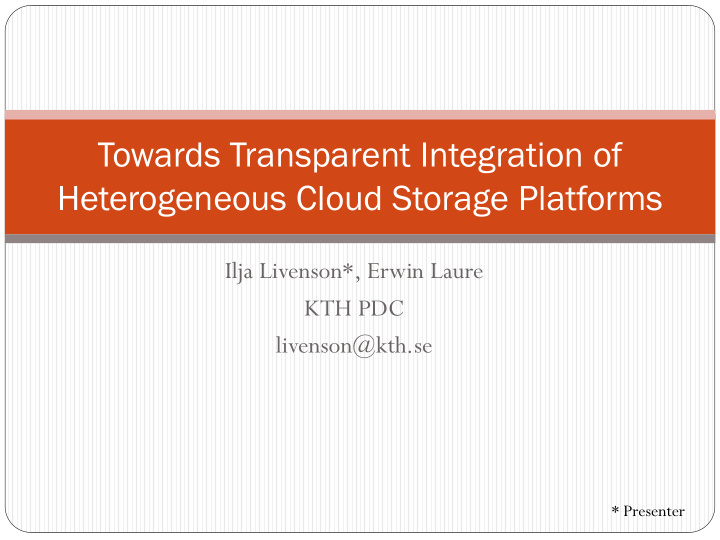



Towards Transparent Integration of Heterogeneous Cloud Storage Platforms Ilja Livenson*, Erwin Laure KTH PDC livenson@kth.se * Presenter
Outline Motivation and problem Our approach CDMI-Proxy Status and roadmap
Background Work done within EU FP7 VENUS-C Project creating a platform that enables user applications to leverage on cloud computing principles; creating a sustainable infrastructure with a valid business model. Resource providers are MS Azure, Engineering, BSC and KTH User scenarios from biomedicine, civil engineering, civil protection and emergencies, marine biodiversity and more.
Problem Lacking component – common storage access mechanism Clouds typically expose RESTful interfaces for file access AWS S3 or MS Azure Blob DCI and local infrastructures (including laptops) tend to provide POSIX interface FS or shared FS Need to offer a compatibility layer
Storage Objects There are three objects with generally close semantics Container Blob Message Queue Each resource provider offers its own flavour of APIs AWS S3 vs MS Azure Blob vs POSIX AWS SQS vs MS Azure Queue vsAMQP
VENUS-C Applications Requirements Blob generic data item + metadata Message Queue FIFO queue Key-value database Aka NoSQL databases Semantics depend on implementation
Data Access Strategies
Motivation for a Proxy Approach Easier exposure of local storage through RESTful API Centralized control over resources Easier access to resources Integration point with existing identity providers Easier release cycle. It is much easier to update a central CDMI-proxy service than a set of deployed libraries Optimization effect from optimizing data of multiple users can be higher than if optimized individually
CDMI SNIA’s Cloud Data Management Interface http://www.snia.org/cloud Standard (1.0.1h) + rising adoption by vendors CDMI provides an interface description for performing a set of operations on the data elements from the cloud CDMI objects: Data Queue Container Domain Capability
CDMI-Proxy Structure CDMI FUSE HTTP FTP CIFS Core AuthZ/AuthN Generic Document Generic Blob Generic MQ DB SimpleDB CouchDB CDMI CDMI Azure Azure Azure local local SQS S3
Data Flow CDMI HTTP request 1. Parse CDMI Request. Frontend CDMI 2. Extract request parameters. 3. Call generic ADT (e.g. blob) with extracted parameters. ADT call with extracted data 1. Divide parameters into data and metadata. Concrete ADT 2. Access metadata in metadata store (e.g. CouchDB) 3. Access data in data store (e.g. blob/mq). 4. Crosscutting: checks and business-logic validation. Metadata (ACLs, ctime/mtime, size, etc) Data (blob content, message value) Metadata Blob/MQ Backend Backend 1. Manage connection with 1. Manage connection with the metadata store. the data backend 2. Search/Load/Save metadata. 2. Load/Save data.
VENUS-C Deployment Models Everything from the laptop Client would need to have a business relationship with a cloud provider VENUS-C on-premises E.g. VENUS-C services deployed at a research group VENUS-C in the cloud E.g. a commercial offer to a company
Demo deployment Local laptop AWS S3 Local FS AWS A CDMI-Proxy CDMI-Proxy Data movement using CDMI: 1. Get data from 3 sources - localdisk via CDMI-proxy - AWS via CDMI-proxy Metadata - localdisk via CDMI-Serve (SARA) Store 2. Create a new folder in CDMI-proxy (Azure backend) (CouchDB) 3. Upload files to a new container. KTH OpenNebula A AWS A CDMI-Proxy CDMI-Serve (SARA) Local FS Azure Blob
Security Crossing of trust domain Integration point with in-house Identity providers AuthZ systems
Client Side Developing CDMI SDKs in .Net, Java and Python, also exporting as CLIs Integration with EMIC’s Generic Worker and BSC COMP Superscalar Community efforts SARA OCCI/CDMI demo from NetApp (More are coming) Commercial offerings Mezeo Cloud
Status and plans Core functionality is getting more mature Supported ADTs: Blobs and Message Queues Extended namespace for 1-level cloud storages (AWS S3, Azure Blob) Delivery of the first prototype is due in Autumn 2011 Prerelease earlier Will not expose document store via CDMI Custom installations at DCIs with a shared security system Will wait for CDMI specification
Roadmap Integration into application’s workflows Ongoing: bioinf, rendering, medical imaging Performance and stability testing 3 rd party transfers with encryption of the content Enrichment of data items with (approximate) costs Basic accounting + interface to VENUS-C accounting and billing engine Dynamic credential passing to allow reuse of personal accounts
Technical Details CDMI-Proxy core Twisted networking engine (Python) Python 2.5+ Backends Metadata store: CouchDB (Azure Table, AWS SimpleDB) Blobs: POSIX, Azure Blob, AWS S3, CDMI MQ: AMQP , Azure Queue, AWS SQS, CDMI
Thank you! http://github.com/livenson/vcdm http://github.com/livenson/libcdmi-java http://github.com/livenson/libcdmi-python
Recommend
More recommend